#jogaila
Text



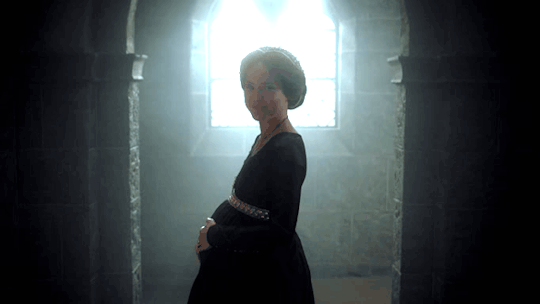

#jadwiga andegaweńska#jogaila#władysław ii jagiełło#korona krolow#korona królów#perioddramaedit#perioddramagif#the crown of the kings#historicalgifs#koronakrolowedit#jadwiga of poland#dagmara bryzek#korona krolow jagiellonowie#s4
23 notes
·
View notes
Photo
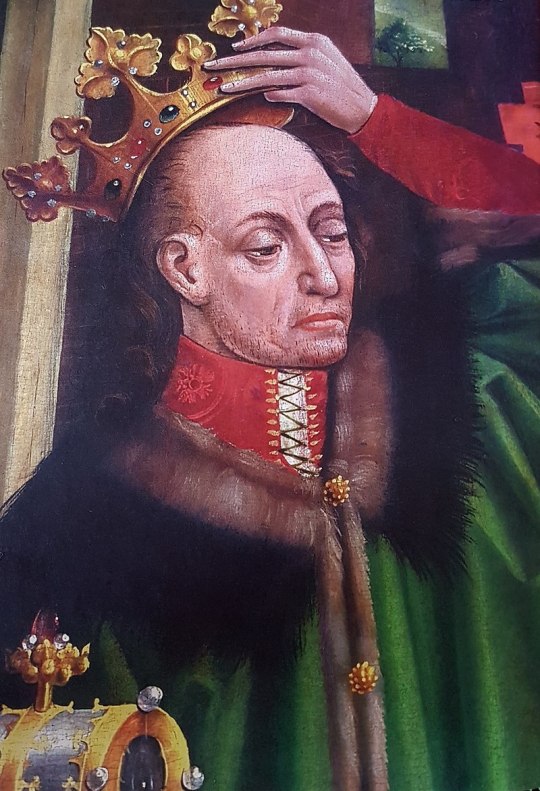
King Władysław II Jagiełło, detail of the Triptych of Our Lady of Sorrows in the Wawel Cathedral.
The Lithuanian Civil War of 1389–1392 was the second civil conflict between Jogaila, King of Poland and Grand Duke of Lithuania, and his cousin Vytautas. At issue was control of the Grand Duchy of Lithuania, then the largest state in Europe. Jogaila had been crowned King of Poland in 1386; he installed his brother Skirgaila as ruler of Lithuania. Skirgaila proved unpopular and Vytautas attempted to depose him. When his first attempt to take the capital city of Vilnius failed, Vytautas forged an alliance with the Teutonic Knights, their common enemy – just as both cousins had done during the Lithuanian Civil War between 1381 and 1384. Vytautas and the Knights unsuccessfully besieged Vilnius in 1390. Over the next two years it became clear that neither side could achieve a quick victory, and Jogaila proposed a compromise: Vytautas would become Grand Duke and Jogaila would remain Superior Duke. This proposal was formalized in the Ostrów Agreement of 1392, and Vytautas turned against the Knights. He went on to reign as Grand Duke of Lithuania for 38 years, and the cousins remained at peace.
#Lithuanian Civil War#Władysław II Jagiełło#Jogaila#Vytautas#House Jagiellon#lithuanian history#civil war#XIV century#paintings#art#arte
5 notes
·
View notes
Text
Luminas Parkas (and @where-is-my-beheading-ceremony) developed my taste in shitty brotp Lithuania&Prussia
Prussia (already not Baltic), tied up, watching Lithuania sharpening the sword: - Wait. WAIT. I have something important to tell you!
Lithuania: Oh really🌸 It doesn't matter anymore🌸 You killed my brother🌸 Prepare to die🌸
Prussia: - I WAS INVITED TO YOUR BROTHER'S HOUSE BY DUKE OF MAZOVIA!!!
Lithuania: :)
Lithuania: What. :)
Prussia, shrinks cause he hears the sound of a flying sword:
The sword: breaks the ropes
Prussia, sweating nervously: Huh
Lithuania: Get dressed. :) We are going to TALK TO POLAND. I have to ask him something 🔥🔥🔥
Prussia, sweating nervously: Wow😀
[FIVE HOURS LATER]
Lithuania: Gudija, why the fuck are you with Poland under the symbol of Jogaila AND WITH TROOPS pointing your swords at us.
Belarus: Well-
Poland: Lithuania, why the fuck are you with Prussia together? Don't you like hate Catholics? Aren't you like blood enemies?
Lithuania: Times are changing. :)
Prussia, with fake tears in his voice: Poland, how dare you invite me to that trap called Baltic Prussia? You made a monster out of me!!! You made my dear brother turn his back on me!!!😭😭😭
Poland: - ...you little chatty bitch.
Lithuania: - Prussia, shut the fuck up. Lenkija, I can't believe my ears. Gudija, I can't believe my eyes.
Belarus: - Sorry Liet, but if you burn the Crooked Castle which I've built with my own hands, I'm gonna beat your ass.
Poland: - Tell him, Litva.
Prussia: *laughs like a donkey*
#The Lithuanian Game of Thrones#Vytautas VS Jogaila#hetalia#hws lithuania#aph lithuania#hws prussia#aph prussia#hws belarus#aph belarus#hws poland#aph poland
12 notes
·
View notes
Text
Republic Of Many Nations - Historical Opportunity for Central/Eastern Europe?
(This is a translation of an exhibition created with the cooperation of multiple Slovak and Polish institutions for the study of history that hanged in the corridors of University of Prešov in late 2023. Consider this an introduction to Rzeczpospolita for all my 1670 girlies. It's heavily biased in favor of Rzeczpospolita, luckily in ways that are neither subtle, nor do they detract from its informational value. I am leaving out most of the pictures and the commentary under them, as well as the quotes included - simply because I couldn't fit them into the format of a tumblr article. The notes bellow in [] brackets are mine, the rest of the text is from the exhibition itself, and the pictures, or something close to them - like the same building from a different angle - appeared on the exhibition panels as well. Commentary on the pictures is also from the exhibition.)
***
Did you know that from the end of the 14th century untill the end of the 18th century a unique republic existed in what is now Poland, Lithuania, Ukraine and Belarus, which was the biggest state in Europe and which wasn't founded by military expansion, but by a peaceful alliance of Kingdom of Poland and Grandduchy of Lithuania? This republic gradually fell to the pressure of surrounding absolutist monarchies led by the Tsardom of Muscovy [1], but its legacy persists in the ethos of civil liberties, democratic participation and diversity. Legacy of this republic has become a part of the identity of nations in the Middle/Eastern Europe, which for more than two centuries resisted Russian imperial rule and which cling to these values to this day.
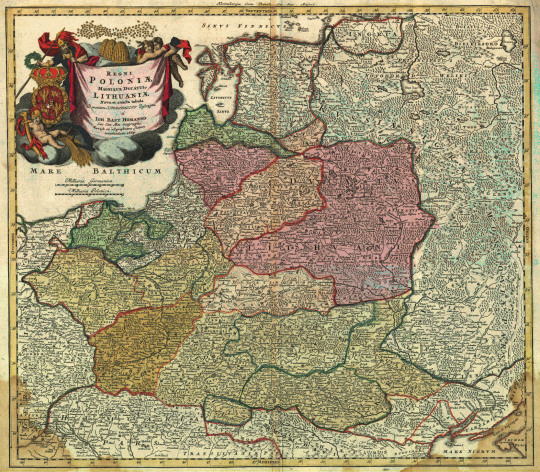
1.) REPUBLIC OF MANY NATIONS
The beginings of the "republic of many nations" can be traced to the year 1385, when the hand of Jadwiga, heir to the Polish throne, was offered to Jogaila, the Grand Duke of Lithuania, with the stipulation that he should become a Christian. When Jogaila ascended the throne of Poland as Władisław II. Jagiełło, it created a dynastic link between Poland and Grandduchy of Lithuania, which besides Lithuania consisted of lands in today's Belarus and Ukraine. When on the 1st of July 1569 in the Lublin Castle Polish nobility agreed to extend their privileges to the Lithuanian nobility in exchange for Lithuania ceding large territories to the Polish crown, an agreement was born, on the basis of which a dynastic union transformed into a commonwealth, now called Rzeczpospolita, i.e. The Republic. Though initially the union of these polities was motivated by the existence of common enemies - the Teutonic Order and later Russia - the strongest bond between them turned out to be the unique arrangement established by the Polish and Lithuanian representatives. The "Republic" in the name of this polity was supposed to demonstrate that the Commonwealth would be ruled by its noble citizens regardless of whether their mother tongue was Polish, Lithuanian or Ruthenian (common ancestor of Rusyn, Belarussian and Ukrainian). Though Republic was for hundreds of years plagued by numerous internal issues, and by the end of the 18th century it was destroyed by the aggression of its neighbours, in 1791 citizens managed to approve a unique document - Constitution of 3 May 1791, now considered the first modern constitution in Europe...
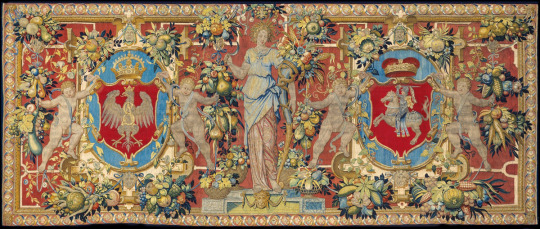
2.) STORY OF THE CROWN AND THE GRANDDUCHY
Even after the Union of Lublin, the Polish Crown and Grandduchy of Lithuania were still separate states, just like they used to be for hundreds of years before that. After all, the rulers of Poland had their own archbishopric and royal title since the early 11th century, struggling for power against the likes of Přemyslids, while the grand dukes of Lithuania, attempting to revive the legacy of Kievan Rus', still hesitated whether to accept baptism from Rome or Constantinople. While many of the differences between them disappeared after the creation of Polish-Lithuanian Commonwealth, as the Lithuanian estates adopted the lifestyles of Polish nobility, the grandduchy continued to have their own legislature in the form of so-called Lithuanian Statutes, as well as their own army and finance, and a strong sense of self-determination. However, the connection between Lithuanian and Polish society was very strong - in October 1791, shortly before the final occupation of the Republic by the Prussians, Russians and Austrians both Polish and Lithuanian representatives agreed upon The Mutual Vow Of Both Nations [2], in which they promised that the story of Rzeczpospolita should continue in perpetuity as an indelible federation of the two countries...

3.) THE STORY OF UKRAINE: A MISSED OPPORTUNITY FOR THE REPULIC?
While its name points to a country "somewhere on the edge", Ukraine was a tempting target for many powers since the Middle Ages. After the fall of Mongolian Golden Horde in the 14th century, it was, as the former core of Kievan Rus' added to Lithuania, which presented itself as a continuation of this great Kievan empire. In this way, Lithuania came into the crosshairs of Muscovy, which held similar aspirations. After 1569 the Commonwealth of Poland-Lithuania, which in many ways respected the distinct Ukrainian identity and unlike Moscow didn't consider it to be just a branch of the Russian nation, became its protector from the Muscovite incursion into Ukraine. Even the Polish-Lithuanian nobility living in Ukraine identified and called themselves "Ruthenians", and Grand Duchy of Lithuania used so-called Ruthenian as its official language. Cossacks living in the Wild Fields in the Dnipro river basin, who on the one hand didn't accept the autority of Polish-Lithuanian nobility, on the other hand helped to safeguard the borders of Rzeczpospolita from Moscow and the Ottomans, were also bearers of the sovereign Ukrainian identity. In the middle of the 17th century dissatisfaction of the Cossacks with certain magnates and issues of religion grew into the bloody uprising of hetman Bohdan Khmelnytsky, who in 1654 turned to the Muscovite tsar [1] with a plea for protection. However, among the Cossacks, critical voices towards Moscow could also be heard, especially the voice of Ivan Vyhovsky, who in 1658 made a deal with the Commonwealth of Poland-Lithuania about its transformation into the Republic of Three Nations with a coequal position of the Grand Duchy of Russia [3] and orthodoxy. Because of the opposition from a portion of nobility, Cossacks and Moscow, the agreement never went into effect, and thus both the Republic and Ukraine missed their historic chance...

4.) KING IS THE FIRST AMONG US, THE FIRST AMONG EQUALS
The creation of Polish-Lithuanian Commonwealth was also a key flashpoint for the transformation of royal power. Since Polish king Sigismund II. August, who thanks to the Union of Lublin became the ruler of Rzeczpospolita, died in 1572 without issue, Polish-Lithuanian nobility in accordance with the original agreement established the viritim election principle, according to which every noble present could elect their own king on special convocational sejms (diets). Ruler elected in this manner had to confirm noble privileges trough the so-called Henrician Articles and a collection of vows Pacta Conventa. Ruler's political power was thus perpetually subject to the rule of law (lex regnat non rex), and if the nobility deemed the ruler's actions unlawful, they could in the case of an emergency even call up a confederation and declare armed resistance. Thus, from then on until the acceptance of Constitution of 3 May 1791, the election of Polish-Lithuanian monarch became subject to the interests of foreign dynasties and local magnate houses. In the 18th century, an era during which the surrounding countries mostly adopted absolutism, the weakness of royal power came to be seen as the fundamental reason for the political decline of the Republic.

5.) NOT A MONARCHY, NOR AN ARISTOCRACY, NOR A DEMOCRACY
The name Rzeczpospolita (the Republic) wasn't chosen for the Commonwealth of Poland-Lithuania by accident. Polish-Lithuanian nobility actually believed that their country can revive the lost ancient legacy of the just polities, and so they considered their Rzeczpospolita, to which they had given the epithet "most serene" [2], to be the third real republic in human history (after the Roman and Venetian ones). Members of the Polish nobility, who were convinced that the noble station brings with itself the duty of civic virtues, thus positioned themselves as the new Aristotles, and considered the so-called mixed constitution, which combined virtues of the monarchy, aristocracy and rule of the people, to be the best way to organize the state. Power in Rzeczpospolita was thus divided between the elected king, the Senate consisting of highest state officials, and a chamber of noble-born representatives, who could use the later infamous liberum veto [4], or the right of individual protest, which especially in the 18th century severely hampered the flexibility of the Republic. However, in the Republic, a specific form of political decisionmaking wasn't practiced only by the parliament of nobles. In Ukraine, the Zaporozhian Cossacks created a very peculiar form of military democracy. In their fortified camps (sietches [2]) the sietch councils formed by direct election, and they in turn elected their military commanders (atamans) and government officials, made decisions about war and piece, economic policy, even legal judgements.
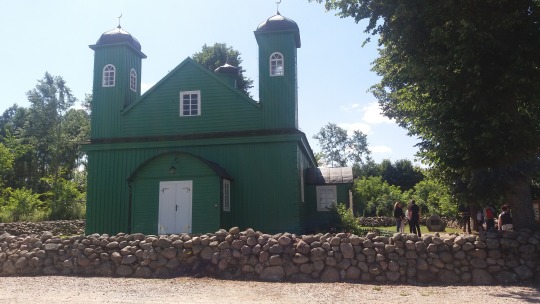
6.) DIFFERENT FAITHS LIVE TOGETHER WITHOUT NEED FOR BORDERS
Calling the ancient Republic "Polish" might be misleading, because today the epithet "Polish" is tied mostly to the ethnic nation. However, since in the Polish-Lithuanian Commonwealth, the nation was the nobility, which based its honour on citizen loyalty towards the common polity inspired by antiquity, the noble "nation" at the time included all members of the class no matter the country they were born in, language they spoke, or the faith they professed. That's why, concerning the question of self-perception in the period, we often see the phrase "I am of the Polish nation, but of Ruthenian birth." This citizenship-based definition of Polish identity was closely related to the unprecedented religious tolerance, as codified in 1573 by the so-called Warsaw Confederation. The fact that the noble "nation" included not only Catholics, Lutherans, Calvinists, Uniates and Orthodox Christians, but Mennonites and Arians, led to Rzeczpospolita being called "a state without stacks", because the foreigners there didn't end up burned at a stake, but finding a refuge. However, in the 18th century, this fragile coexistence of different denominations was severely disturbed, because the neighbouring great powers loved to use the rights of religious minorities for their own ends. In the 3 May 1791 constitution, all faiths were thus tolerated, but the Catholicism was supposed to be the state religion.

7.) POLONIA PARADISUS JUDAEORUM
While the Jewish people were often banished from the rest of medieval European countries, kings of Poland granted many privileges to the arriving Jews. That being not just The Great Charter of Jewish Rights [2] from 1264, but also Privilegia de non tolerandis Christianis, which allowed Jewish merchants to settle in designated communities without Christian competition. Jews gradually gained the right to their own local administration (so-called kahalas) and around the time of the Union of Lublin even to summon their own parliament, called the Diet of the Four Countries [2] (also known as Va'ad). It is therefore no wonder that in the 16th century Europeans started to call Rzeczpospolita "Jewish paradise" and that three quarters of the entire Jewish population of the world lived here. This peaceful coexistence started to suffer in the middle of the 17th century, mainly because of Cossack uprisings, during which thousands of Jews were massacred for being alleged allies of the nobility, while in the 18th century the country experienced general decline in religious tolerance. However, as part of the attempt to save the Republic during the so-called Great Sejm [2] of 1788-1792, a special commission was created to designate the position of Jews within Rzeczpospolita. And when the famous Kościusko uprising defending the independence of Rzeczpospolita and the legacy of the Constitution of 3 May 1791 against the Russian invasion broke out, many Jews didn't hesitate to join the first Jewish regiment and fight in battle for the Republic.
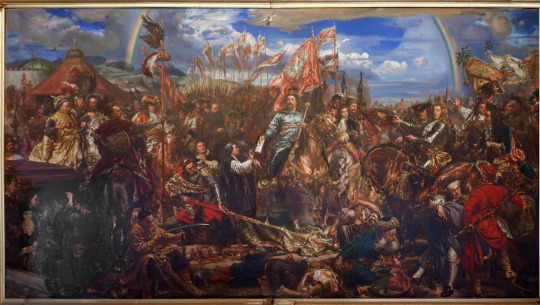
8.) WALLS OF CHRISTIAN EUROPE
Noble citizens didn't perceive their Republic as just an embodiment of ancient community, but also a military power. That's why the nobility placed so much value on military virtues and in emulation of ancient Sarmatians, whose descendants they considered themselves to be, they also relied heavily on elite cavalry - the winged hussars, whose exotic appearance and military prowess gained them respect on the battlefield. Polish-Lithuanian nobility, convinced of the exceptional nature of their own Republic, started to perceive their polity as "antemurale christianitatis" - the bastion of Christendom, which protects the eastern borders of Europe from the outside threat. In the 1621 battle of Khotyn the united Polish-Lithuanian army, boosted by thousands of Cossacks led by the hetman of Zaporizhzhia Sahaidachny, a great promoter of cooperation between the Cossacks and Poland-Lithuania, managed to hold back the Ottoman army several times its size. The Polish society connected several such victories to the Divine providence and a faith that the Republic is fulfilling its holy mission in history. This is also the reason why the hussars of king Jan III. Sobieski are to this day considered the saviours of Vienna from the Ottoman siege of 1683 and the madona of Czenstochowa is perceived as the one responsible for the Polish-Lithuanian victory over the Swedes. Though the military glory of the former empire had declined in the 18th century, the enlightenment era reformers didn't forget the valor of their ancestors - the School of Chivalry was established on the prompting of king Stanislaw August Poniatowsky, and among its absolvents was Tadeusz Kościuszko, born in the Duchy of Lithuania, leader of the last stand of the Republic against Russia in 1794.
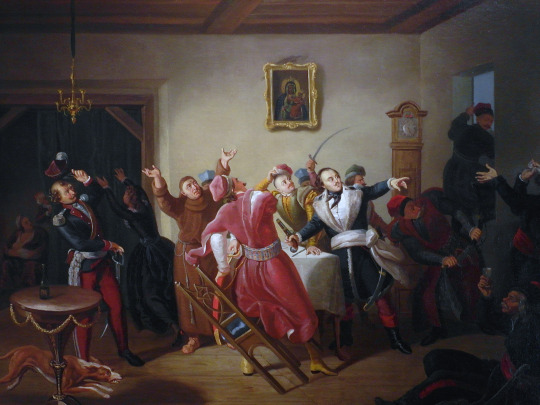
9.) NOTHING ABOUT US WITHOUT US
While the king od France could've said "I am the state", in the Polish-Lithuanian Union the state were its citizens, that being the nobility. Nobility's agitation for their privileges gradually bore fruit - particularly important were the neminem captivabimus privilege, ensuring untouchability of a person, and the nihil novi rule, forbidding the king from issuing laws without the approval of a diet of nobles. Power of the nobility was among other things ensured by the size of this estate, since it made up 8-10% of the population (for comparison, in Great Britain, even in the mid-19th century only 6% of the population had a right to vote). In comparison with other countries, all members of the nobility were absolute equals in the eyes of the law. All of these rules were supported by the specific ideology of sarmatism, according to which were all noblemen, as the alleged descendants of the ancient ethnic group, required to protect the so-called "golden liberties" - set of rights and values which made the Polish-Lithuanian nobility consider themselves the most free nation under the the sun. Besides the exotic clothing [5], sarmatism was also expressed in numerous acts of rebellion against their own king - for example, in the 18th century nobility founded the Bar Confederation, which was supposed to rid the Commonwealth of the Russian influence, but ended up leading to the first division of Rzeczpospolita lands among the imperial powers.
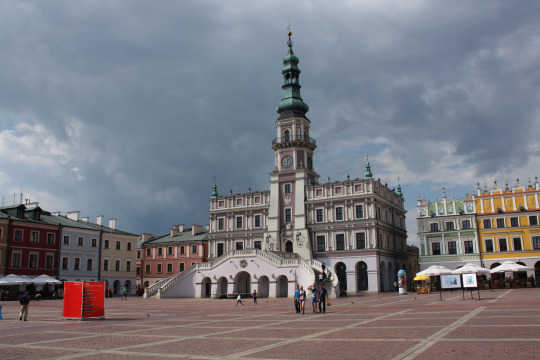
10.) SPLENDOR AND MISERY OF THE MAGNATE FAMILIES
Though in the Commonwealth, any use of titles that would distinguish between lower and higher nobility was strictly forbidden, the issue was nonetheless made more complicated by the high economic inequality even among the nobles. Some noble houses were able to create estates so large even the royal holdings paled in comparison. Their dominance rested on their large wealth, high positions in state offices and background influence on politics. This informal class of magnates was most prominent in the eastern part of the country, where a handful of houses amassed giant private armies and sophisticated webs of noble clients, since many of the impoverished nobles voluntarily worked for the magnates, and some even voted in the parliament according to the wishes of their benefactors. These most powerful magnates were thus also titled "little kings", and some of them actually did become elected kings of Poland. The fact that many magnates, especially in Ukraine, were out of the reach of central state power and treated their subjects especially badly led to the outbreak of antimagnate rebellions, the most successful of which was the Bohdan Khmelnytsky Cossack uprising of 1648. However, the magnate activity cannot be seen as black-and-white, because their role also involved foundation and patronage on a grand scale - it was thanks to them that many treasures of Polish-Lithuanian architecture were created.

11.) LEGACY OF THE REPUBLIC OF MANY NATIONS
The Republic of Poland-Lithuania was erased from the map in 1795. However, its tradition remained in the ethos of fight "for freedom yours and ours", which was echoed by the participants of many antirussian uprisings in the 19th and 20th century. This ethos called back to the tradition of free republic, which, unlike the Russian Empire - that forced subjugated polities to adopt the samoderzhavie [6], orthodoxy and russification triad - supposedly enabled different nations to keep their freedom and "unity in diversity". Although the ethnonationalism of the 20th century has dimmed the memories of their common legacy and caused plenty of bad blood among the different nations of former Rzeczpospolita, the idea of confederation or close cooperation against Russian imperialism was returning in their consciousness, whether during the 1863 uprising or shortly after World War I. In the communist era, the writer in exile Jerzy Giedroyc famously prophesized that Poland can be truly free only when so are Lithuania, Belarus and Ukraine. For Ukrainians and Belarussians, who have been threatened by the imperial idea of Greater Russia and the vision of a unified "Russian world" even after 1991, are heroes (like prince Konstanty Ostrogski or hetman Sahaidachny) and famous moments in the history of the Republic fundamental symbols of their national sovereignty and belonging to the European civilizational space. They will never cease to remind everyone that the Republic is not dead while we are alive and believe that the ties of mutual civic loyalty are stronger than differences in language, faith or ethnic origin, stronger than any enemy that would attempt to tear these ties of our values.
***
[1] - Russia. They are talking about Russia. Y'see, the etymology of "Russian" in Eastern Slavic languages is kinda confusing; originally, it meant all Eastern Slavs, but later on it came to be associated with the largest and most culturally dominant group - which is to say the predecessors of modern Russians under the rule of Princedom of Muscovy. Eventually, Ivan IV., the Grand Prince of Muscovy got himself crown the Tsar of All Russians, which was a bit presumptuous considering a whole lot of people who very much weren't under his rule also identified as the Rus'/Russians. Still, it stuck, and when Ukrainians and Belarussians wanted to define themselves against their Russian overlords, they abandoned the label "Russians" altogether. Calling post-Ivan the Terrible Russians "Muscovites" is a bit of antiquated terminology that would be common in Polish-Lithuanian Commonwealth.
[2] - Literal translation, because I don't know what it's called in English-speaking historical literature.
[3] - Used here in the older sense of the word, i.e. Eastern Slavic in general (see [1]). In this case, the Eastern Slavs in question are clearly mostly Ukrainians despite being called Rus'/Russians (YES I KNOW)
[4] - Okay, so have you seen the first episode? The whole "One of us was against. End of story. We have a democracy." thing was... Barely an exaggeration to be honest.
[5] - Compare the shit Jan Paweł and his friends wear to normal 17th century male clothing (to which Ciesław and especially magnate's son come pretty close to) and you'll get the gist.
[6] - rus. autocracy, or rather the name for specific absolutist tradition of Russian tzars
***
Notes on the pictures:
1.) Map of Rzeczpospolita from the first half of the 18th century (most likely around 1739), made by the cartographer Johann Baptist Homann.
2.) Tapestry with the coats-of-arms of Poland and Lithuania - The Union of Lublin led among other things to the joining of Polish and Lithuanian coats-of-arms, so the new state coats-of-arms combined the polish royal eagle on red field with the traditional symbol of Lithuania, the Pogoń (Vytis in Lithuanian), or the armored knight on a horse, which to this day is part of the legacy of the Grandduchy in modern Lithuanian and parts of Belarussian society.
3.) Battle of Orsha (1514) in which the orthodox prince Konstanty Ostrogski, claiming to carry on the legacy of the Kievan Rus', led the united Polish-Lithuanian forces and destroyed the Muscovite invasion army despite being outnumbered, saving the independence of the Grandduchy. After 1991 the day of the anniversary of this battle was celebrated as a holiday of the Belarussian army. The holiday was later abolished by the Lukashenko regime, one can currently end up in jail for celebrating it. In 2017, a common Lithuanian-Polish-Ukrainian brigade was named hetman Ostrogski.
4.) Royal Castle in Warsaw - Since the late 16th century, Warsaw became the new center of power in the Republic. The Royal Castle, originally the medieval seat of the dukes of Massovia, was rebuilt in the new baroque style. During World War II, the castle was completely destroyed. For a long time, the communist regime was refusing to greenlight its reconstruction, and its restoration based on old engravings and pre-war photographs was only made possible trough the massive public pressure.
5.) Painting of the French artist Jean-Pierre Norblin portrays a traditional part of the political life in Rzeczpospolita - a session of the so-called sejmik (Polish diminutive of sejm, a.k.a. diet). On these local assemblies of nobles of the given region, deputies for the meetings of the central sejm were elected and instructions for these deputies were agreed upon.
6.) Kruszyniany - Presence of the muslim Tartar community is part of the legacy of Rzeczpospolita. Tartars live on the territories of today's Lithuania, Belarus and Poland continuously since the 14th century. They have proven their worth as warriors in service of the Republic. Original Tartar mosques can be found especially in Podlesie in today's northeastern Poland and in Trakai in today's Lithuania.
7.) Ceiling of a synagogue reconstructed for the POLIN Museum of the History of Polish Jews in Warsaw, which in 2015 was awarded the title of Best Museum in Europe. It is in this modern museum that you can learn the most about the Jews of Rzeczpospolita, the largest Jewish diaspora at the time.
8.) Sobieski at Vienna - Painting of Jan Matejko depicts the Polish king Jan III. Sobieski, who after his famous triumph over the Ottoman Turks in 1683 sent a letter to pope Innocent IX., in which he writes that the Christian Vienna was saved.
9.) Casimir Pulaski, later national hero of the United States, escaped Poland after the failure of the Bar Confederation in 1769-1772. The confederation was one of the last attempts to free the country from the increasing dependency on Russia.
10.) Zamoćś - Renessaince city founded by an exceptional person. Jan Zamoyski came from a not very wealthy noble family, but trough his own merits eventually became the richest and most powerful man in the Republic. The town hall of Zamość on the photo.
11.) Adam Mickiewicz could be the symbol of the common legacy of Rzeczpospolita. The greatest poet in the Polish language literature was born in today's Belarus (1798) and always felt like a citizen of Rzeczpospolita. His most important work begins with a line "Lithuania, my fatherland!" It was Mickiewicz who was remembered by the pope John Paul II., when he proclaimed the Polish-Lithuanian Commonwealth the predecessor of cooperation of the entire continent within the European Union ("from the Union of Lublin to the European Union").
10 notes
·
View notes
Text

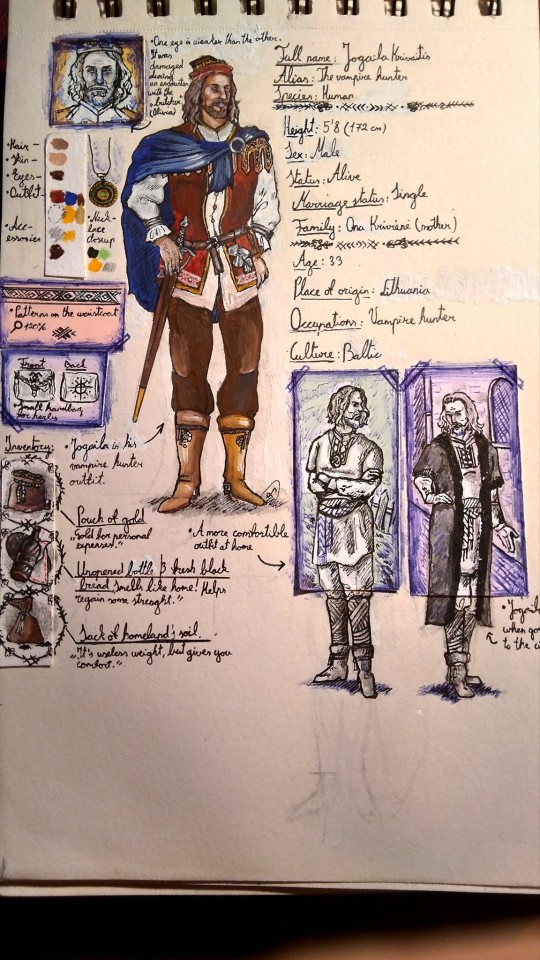
Jogaila is the folk hero, raised from nothing. He is described as a hard-working and mostly unlucky man, often engaging in struggle with all kinds of monsters and creatures.

•••
Born in a poor village household, now with a young face ruined by hard life and work over the years, Jogaila always wanted more in life. When drowning your sorrows in alcohol and complaining about small coin doesn't help, the simple man takes a common steel and a common mare on a journey. He wanted to serve the nobles since his youth and roam the city's streets often, so to start somewhere he took the position of a hunter, to see where that would take him.
7 notes
·
View notes
Text
A series of portraits of the Targaryen dynasty by the renowned Braavosi painter Mateyko Yan
I got inspired by @nanshe-of-nina's artasoiaf series and I thought... huh... there's a set of drawings showing various kings that could work in this context...
(Sorry Polish followers for any brain damage you may get from this post)


Aegon the Conqueror with his sister-wife, Visenya (Rhaenys' portrait sadly was lost to time).
[Bolesław IV the Curly as Aegon and Anna Jagiellon as Visenya]

Maegor the Cruel
[Bolesław III Wrymouth]


Jaehaerys I and his sister-wife Good Queen Alysanne (Jaehaerys' portrait shows him by the end of their reign, while Alysanne is portrayed as a young queen).
[Mieszko III the Old and Richeza of Lotharingia]
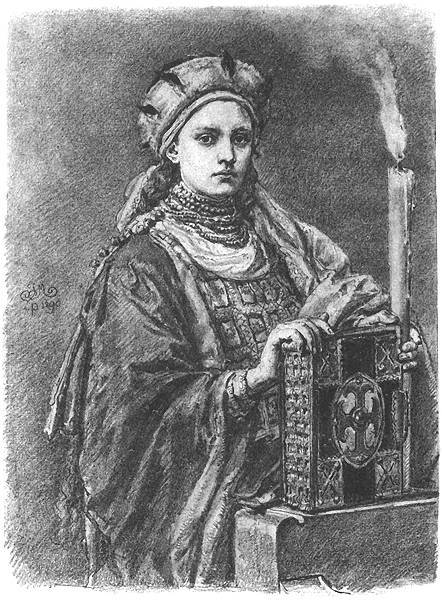
Rhaenys Targaryen, the Queen who Never Was
[Doubravka of Bohemia]

Daemon the Rogue Prince (here portrayed with the coat of arms of the house Arryn; possibly during his stay in the Vale of Arryn as the husband of lady Rhea Royce)
[Leszek the White]

Viserys II
[Władysław II Jagiełło/ Jogaila]
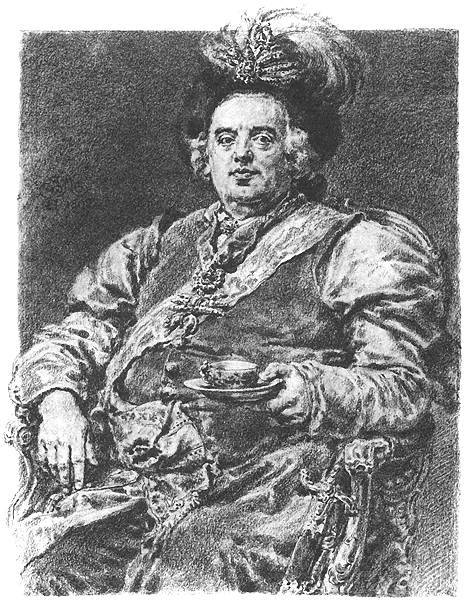
Aegon IV the Unworthy
[Augustus III]
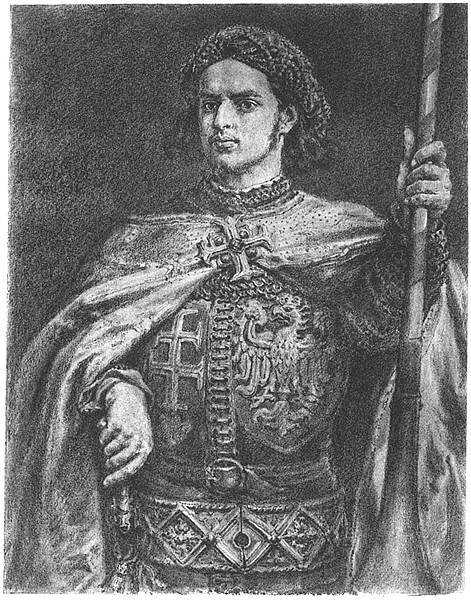

Maron Nymeros Martell, the ruling prince of Dorne, and his sister Myriah, the queen consort of Daeron II
[Władysław III of Varna and Jadwiga]
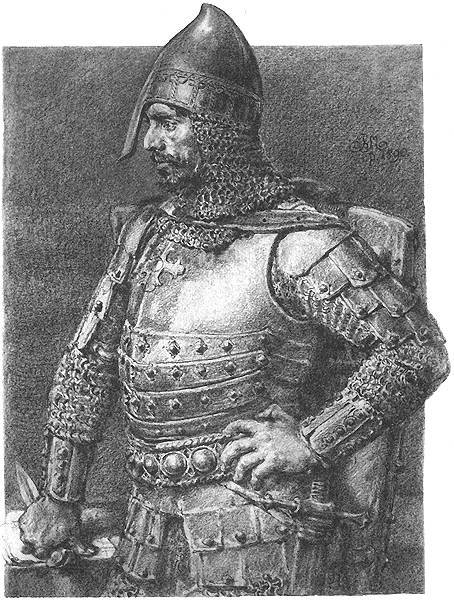
Baelor Breakspear, son of Daeron II
[Konrad I of Masovia]

Aerion Brightflame, son of Maekar I
[Władysław III Spindleshanks]
#I hope I managed to capture their Vibes#also Matejko gave too many people dark hair so I didn't have that much to choose from#lmao#asoiaf#a song of ice and fire#fire and blood#targaryen#I feel sick in the head for making it tbh#aegon targaryen#visenya targaryen#alysanne targaryen
8 notes
·
View notes
Text
WIP tag game
thank ye @council-of-beetroot for tagging me :>
Rules: Reveal the titles of the documents in your WIP folder and tag as many people as there are documents. Let others ask questions about the ones that interest them and post snippets or explain the contents as you see fit!
The Amber Necklace: a deep dive into a headcanon of mine where Lithuania wears an old amber necklace every day (alongside some others too). Gonna span snippets of time from the marriage day of Jadwiga and Jogaila, to the fall of the Polish-Lithuanian commonwealth, imperialist rule, time in America, back to soviet rule, and present day-ish. As I read this summary I realize it’s gotten a little more involved than it was in its beginning 😅. I meant to write this one first; now instead it feels like I’m working backwards through character development in my other fics whoops.
prussia gets a hug and a party: a less angsty oneshot I worked on to procrastinate writing for Nuclear Family, will likely be posted after NF is finished. Prussia returns to Berlin over the wall and finally learns what’s been going on with his people, and his family.
Hmm: this title is the equivalent of seeing a saved blank canvas on a digital art program iykyk. America & Lithuania centered.
Prussia strongest/weakest script: half baked script of a comic where prussia answers questions about his strongest and weakest moment.
snoozing: there’s like half a sentence in this one lol. Supposed to be Finland & denmark snoozing together during wartime.
Nightmare Before Christmas AU: bare bones list of characters for my… nightmare before Christmas (ish) AU
I don’t know very many writers on here that weren’t tagged in the first one so ;;; @slowrites @samrut and anyone else who is desperate to talk about their WIPs and need an excuse to. Do it. Do it.
#Hetalia#hetalia fanfiction#hws Lithuania#hws prussia#I also have a scraps doc for bits n pieces I cut out from others but wanted to hold onto
4 notes
·
View notes
Note
Dzień Dobry!!!! 😊
5. Worst Character Stans
6. Worst Historical takes
7. Overrated Character
14. Dumbest reason for fandom drama
24. Confess your sinful Hetalia thoughts
6. Shout out to someone on Tumblr who has the best takes for your favorite character
20. List three blogs you want to shout out
22. Why did you start watching Hetalia
dzień doberek! 💕
5. r*ssia stans. there's no justification for this man, he's pure evil. people like him only because he does this stupid face (^J^) (and when they mix hetalia with real live events my blood starts to boil).
6. remember that episode when Finland was talking to Sweden about Battle of Grunwald and Finland said that Poland randomly started to pray??? yeah, this never happened. Hima probably saw the famous painting with praying Jogaila, who was in fact the King of Poland at that time, but he was Lithuanian (so why was this Poland and not Liet?) + these are just speculations, he probably did not pray at all before/during the battle (the king I mean) and this is just a painting + as far as I know the lithuanian army did not randomly leave the battlefield so that's also probably just Hima's fantasy.
(you see I'm very bitter about this)
7. France, England, Canada and America, sorry, I think they're boring and I keep seeing them everywere.
14. I don't know ;v;
24. Sinful like... spicy??? I don't think I have any...
(But China is weirdly hot) (yk countries are like wine — the older the better)
6. shout out to @lietpolski and @samrut and you 👊
20. @baluciarz @bumble-pszcz @turtle-lips hi!
22. ok ok, this was so long ago, one day (night actually) I watched the first episode on yt with polish sub (i was surprised it was even there????) and I immediately got hooked after the first 10sec. I was 12 and very happy that they talk about us in an anime! :D
6 notes
·
View notes
Text
Wrapped up the first of two books on the Baltic region:
Wrapped up the first of two books on the Baltic region. This one covers a somewhat-neglected aspect of the Crusades, the wars in Northern Europe between military orders and the last vestiges of paganism (and the extension of the principle of the Fourth Crusade against Veliki Gospodin Novgorod). These wars started in the 1100s but are mostly famous for two battles, both of them involving Veliki Novgorod. One is the Battle of Lake Peipus, not least for its immortalization in a Soviet anti-Nazi propaganda film by Sergei Eisenstein. The other is the Battle of Tannenberg where Poland-Lithuania fought its first major battle as a unified state and completely wrecked the shit out of the German military order facing them.
These were but two battles in a much longer process whose main contributions to history were to lay the foundation of the Baltic Germans, who were essential to holding together Tsarist Russia, and to transform Baltic Prussia into the eastern territories of the Margravate of Brandenburg, which ultimately renamed itself after these territories and as the archetypal army with a country would unify the German lands into a single state for the first time in history.
Not a single soul involved in the interminable butchery and holy wars in the Baltic Sea described here would understand that this was the ultimate outcome of the events in question. From their perspective they were Christians fighting not merely the metaphorical propaganda paganism of Islam but the last outposts of European polytheism, which fell in the 1380s when Grand Duke Jogaila of Lithuania converted and became the first ruler of Poland-Lithuania (which really should have been Lithuania-Poland as the east was the more powerful of the two but I digress).
Between the ultimate conversion of Lithuanians, Latvians, and Estonians (as we'd define them today in any event) to Catholicism, the Germanization of the Prussians, and the replacement of the unstable quasi-demilitarized Veliki Novgorod with the iron-fisted tyranny of Moscow the Northern Crusades ended in another pattern the architects of the 1100s would never have seen, nor expected. They ultimately furthered the rise of state formation and the transformation of Northern Crusades into various Northern Wars that would finally end when Tsar Peter the Great shattered the Swedes and the last vestiges for centuries of Ukrainian aspiration to escape Muscovite control in the Battle of Poltava.
9/10.
#lightdancer comments on history#book reviews#european history#medieval history#baltic history#northern crusades
2 notes
·
View notes
Text
Watch "jadwiga&jogaila ❝deadly kiss❞" on YouTube
youtube
Jogaila and Jadwiga
4 notes
·
View notes
Text
Lithuania
General Information
Lithuania is one of the Baltic countries in Northeastern Europe. In the 13th century, Lithuanian tribes united to withstand outer threats, with Mindaugas crowned king in 1253. In 1386, a Union between Lithuania and Poland was created due to the marriage of Lithuanian Grand Duke Jogaila and Polish Queen Jadwiga, developing to the Polish-Lithuanian Commonwealth in 1569. With the partitions of the late 18th century, the country ceased to exist and Lithuania mostly fell under Russian rule. In 1918, Lithuania gained independence until getting annexed by the Soviet Union, of which it stayed part until the Soviet Union’s collapse in 1991, during the latter part of World War II. Today, around 86% of the 2.8 Million inhabitants are ethnic Lithuanians, 5.7% are ethnic Poles, 4.5% ethnic Russians. About 77% of inhabitants are Roman Catholic. The capital is Vilnius.
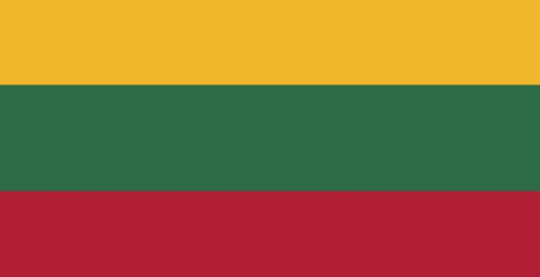
~ Anastasia
Economy
The economy of Lithuania is the largest economy among the three Baltic states. Lithuania is a member of the European Union and belongs to the group of very high human development countries and is a member of the WTO and OECD. In the 1990s, Lithuania rapidly moved from a centrally planned economy to a market economy, implementing numerous liberal reforms. It enjoyed high growth rates after joining the European Union along with the other Baltic states, leading to the notion of a Baltic Tiger. Lithuania's economy (GDP) grew more than 500 percent since regaining independence in 1990. The Baltic states have a combined workforce of 3.3 million people, with 1.4 million of these working people living in Lithuania.

~ Damian
Sources:
https://www.britannica.com/place/Lithuania
https://en.wikipedia.org/wiki/Economy_of_Lithuania
2 notes
·
View notes
Text

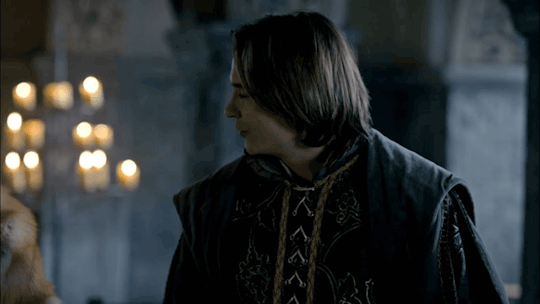



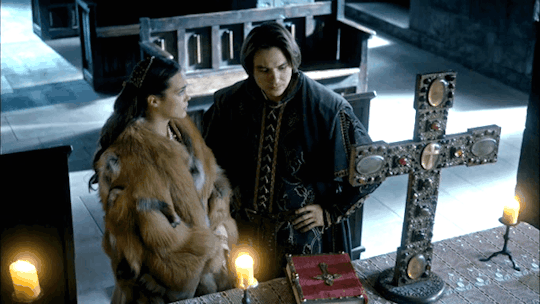
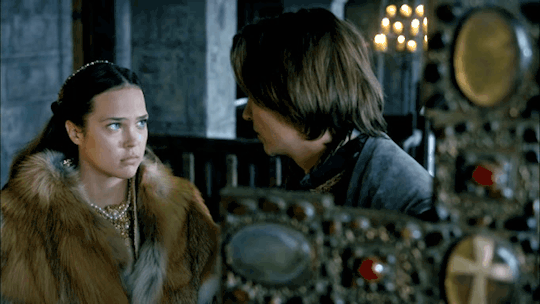
#jogaila#władysław ii jagiełło#jadwiga andegaweńska#jadwiga of poland#dagmara bryzek#vasyl vasylyk#korona krolow#korona królów#the crown of the kings#koronakrolowedit#perioddramaedit#perioddramagif#historicalgifs
11 notes
·
View notes
Text
Events 3.4 (before 1900)
AD 51 – Nero, later to become Roman emperor, is given the title princeps iuventutis (head of the youth).
306 – Martyrdom of Saint Adrian of Nicomedia.
581 – Yang Jian declares himself Emperor Wen of Sui, ending the Northern Zhou and beginning the Sui dynasty.
852 – Croatian Knez Trpimir I issues a statute, a document with the first known written mention of the Croats name in Croatian sources.
938 – Translation of the relics of martyr Wenceslaus I, Duke of Bohemia, Prince of the Czechs.
1152 – Frederick I Barbarossa is elected King of Germany.
1238 – The Battle of the Sit River begins two centuries of Mongol horde domination of Russia.
1351 – Ramathibodi becomes King of Siam.
1386 – Władysław II Jagiełło (Jogaila) is crowned King of Poland.
1461 – Wars of the Roses in England: Lancastrian King Henry VI is deposed by his House of York cousin, who then becomes King Edward IV.
1493 – Explorer Christopher Columbus arrives back in Lisbon, Portugal, aboard his ship Niña from his voyage to what are now The Bahamas and other islands in the Caribbean.
1519 – Hernán Cortés arrives in Mexico in search of the Aztec civilization and its wealth.
1628 – The Massachusetts Bay Colony is granted a Royal charter.
1665 – English King Charles II declares war on the Netherlands marking the start of the Second Anglo-Dutch War.
1675 – John Flamsteed is appointed the first Astronomer Royal of England.
1681 – Charles II grants a land charter to William Penn for the area that will later become Pennsylvania.
1769 – Mozart departed Italy after the last of his three tours there.
1776 – American Revolutionary War: The Continental Army fortifies Dorchester Heights with cannon, leading the British troops to abandon the Siege of Boston.
1789 – In New York City, the first Congress of the United States meets, putting the United States Constitution into effect.
1790 – France is divided into 83 départements, cutting across the former provinces in an attempt to dislodge regional loyalties based on ownership of land by the nobility.
1791 – Vermont is admitted to the United States as the fourteenth state.
1794 – The 11th Amendment to the U.S. Constitution is passed by the U.S. Congress.
1797 – John Adams is inaugurated as the 2nd President of the United States of America, becoming the first President to begin his presidency on March 4.
1804 – Castle Hill Rebellion: Irish convicts rebel against British colonial authority in the Colony of New South Wales.
1813 – Cyril VI of Constantinople is elected Ecumenical Patriarch of Constantinople.
1814 – War of 1812: Americans defeat British forces at the Battle of Longwoods between London, Ontario and Thamesville, near present-day Wardsville, Ontario.
1837 – The city of Chicago is incorporated.
1848 – Carlo Alberto di Savoia signs the Statuto Albertino that will later represent the first constitution of the Regno d'Italia.
1849 – President-elect of the United States Zachary Taylor and Vice President-elect Millard Fillmore did not take their respective oaths of office (they did so the following day), leading to the erroneous theory that outgoing President pro tempore of the United States Senate David Rice Atchison had assumed the role of acting president for one day.
1861 – The first national flag of the Confederate States of America (the "Stars and Bars") is adopted.
1865 – The third and final national flag of the Confederate States of America is adopted by the Confederate Congress.
1865 – U.S. politician Andrew Johnson made his drunk vice-presidential inaugural address in Washington, D.C.
1878 – Pope Leo XIII reestablishes the Catholic Church in Scotland, recreating sees and naming bishops for the first time since 1603.
1882 – Britain's first electric trams run in east London.
1890 – The longest bridge in Great Britain, the Forth Bridge in Scotland, measuring 8,094 feet (2,467 m) long, is opened by the Duke of Rothesay, later King Edward VII.
1899 – Cyclone Mahina sweeps in north of Cooktown, Queensland, with a 12 metres (39 ft) wave that reaches up to 5 kilometres (3.1 mi) inland, killing over 300.
0 notes
Text
You know, how every cuisine has an acceptable popular abroad dish (Japanese ramen), and a completely cursed unpopular abroad dish (Japanese "dancing squid" or natto)?
Well, Lithuania has them, too. :D And if a popular abroad is cepelinai, then a completely cursed one is... I call it "megurkai" - from "medus & agurkai"



Yes. It's cucumbers with honey. Despite being Ukrainian, I have never EVER heard and tried such a combination before, but it seems it's a very popular dish in Lithuania.
"...when you eat fresh cucumbers with fresh honey in the summer, keep in mind that you are eating a dessert worthy of a ruler - about 600 years ago, only Jogaila or Vytautas could afford one," says R. Laužikas, quoted in the press release."
"The researcher of culinary heritage adds that in Jogaila's estate, cucumbers are not considered a vegetable, but a fruit. That's why it was like a dessert after a hearty lunch. In later times, in the 17th-19th centuries, cucumbers with honey were recognized by our country's neighbours as a real exotic Lithuanian delicacy."
They should make a proper advertising of it and serve it in 5-stars restaurants. More about megurkai.
2 notes
·
View notes
Text
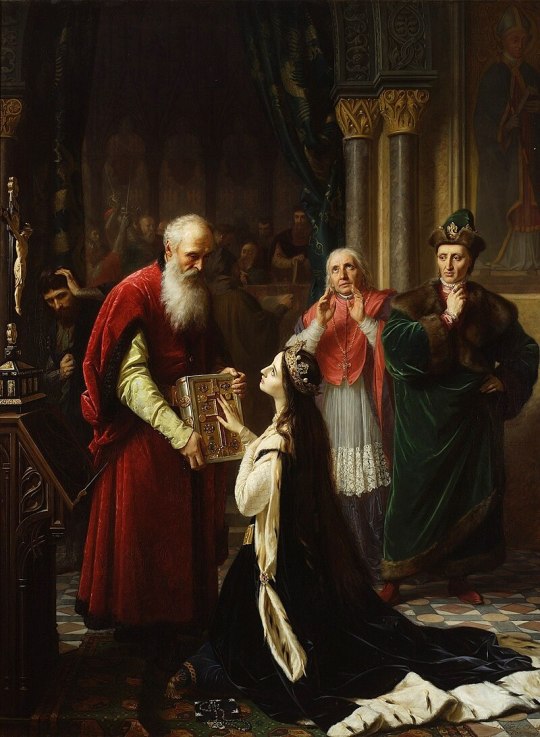
Jadwiga (1373 or 1374 – 17 July 1399), also known as Hedwig, was the first woman to be crowned as monarch of the Kingdom of Poland. She reigned from 16 October 1384 until her death. She was the youngest daughter of Louis the Great, King of Hungary and Poland, and his wife, Elizabeth of Bosnia. Jadwiga was a member of the Capetian House of Anjou, but she had more close forebears among the Polish Piasts than among the Angevins.
In 1375, it was planned that when becoming old enough, she would marry William of Austria and she lived in Vienna from 1378 to 1380. Jadwiga's father is often thought to have regarded her and William as his favoured successors in Hungary after the 1378 death of her eldest sister, Catherine, since the following year the Polish nobility had pledged their homage to Louis' second daughter, Mary, and Mary's fiancé, Sigismund of Luxembourg. However, Louis died, and in 1382, at her mother's insistence, Mary was crowned "King of Hungary". Sigismund of Luxembourg tried to take control of Poland, but the Polish nobility countered that they would be obedient to a daughter of King Louis only if she settled in Poland.
Queen Elizabeth then chose Jadwiga to reign in Poland, but did not send her to Kraków to be crowned. During the interregnum, Siemowit IV, Duke of Masovia, became a candidate for the Polish throne. The nobility of Greater Poland favored him and proposed that he marry Jadwiga. However, Lesser Poland's nobility opposed him, and they persuaded Queen Elizabeth to send Jadwiga to Poland.
Jadwiga was crowned king in Poland's capital, Kraków, on 16 October 1384. Her coronation either reflected the Polish nobility's opposition to her intended husband, William, becoming king without further negotiation, or simply, emphasized her status as the monarch. With her mother's consent, Jadwiga's advisors opened negotiations with Jogaila, Grand Duke of Lithuania, who was still a pagan, concerning his potential marriage to Jadwiga. Jogaila signed the Union of Krewo, pledging to convert to Catholicism and to promote conversion of his pagan subjects. Meanwhile, William hastened to Kraków, hoping to marry his childhood fiancé, Jadwiga, but in late August 1385 the Polish nobles expelled him.
Jogaila, who took the Catholic baptismal name Władysław, married Jadwiga on 15 February 1386. Legend says that she had agreed to marry him only after lengthy prayer, seeking divine inspiration. Jogaila, now styled in Polish as, Władysław Jagiełło, was crowned King of Poland on 4 March 1386 as Jadwiga's co-ruler. Jogaila worked closely with his wife in that role. In any case, her real political power was limited.
She remained passive when the rebellious nobles of the Kingdom of Hungary-Croatia murdered her mother in early 1387. After that, Jadwiga marched into the Kingdom of Galicia–Volhynia, which had been under Hungarian rule, and persuaded most of the inhabitants to become subjects of the Polish Crown. She mediated between her husband's quarreling kin and between Poland and the Teutonic Order.
After her sister Mary died in 1395, Jadwiga and Jogaila laid claim to Hungary against the widowed Sigismund of Luxembourg, but the Hungarian lords did not support their claim and Sigismund easily retained his Hungarian throne. Jadwiga died four years later due to postpartum complications.
In 1997, Jadwiga was canonized by the Catholic Church.
1 note
·
View note
Text
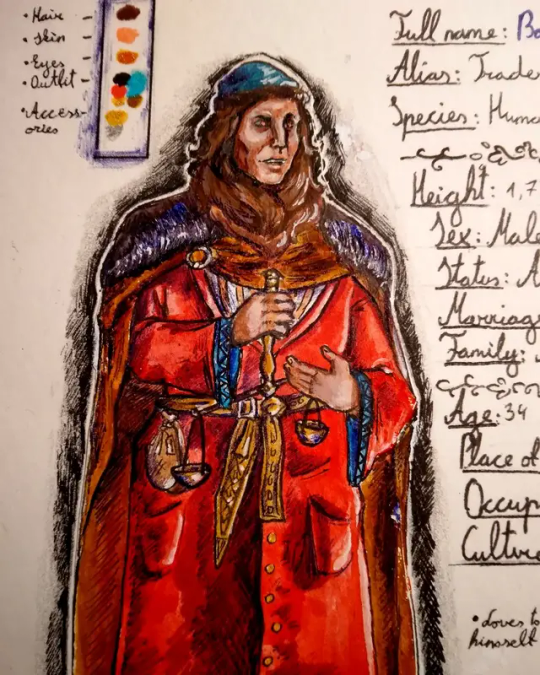
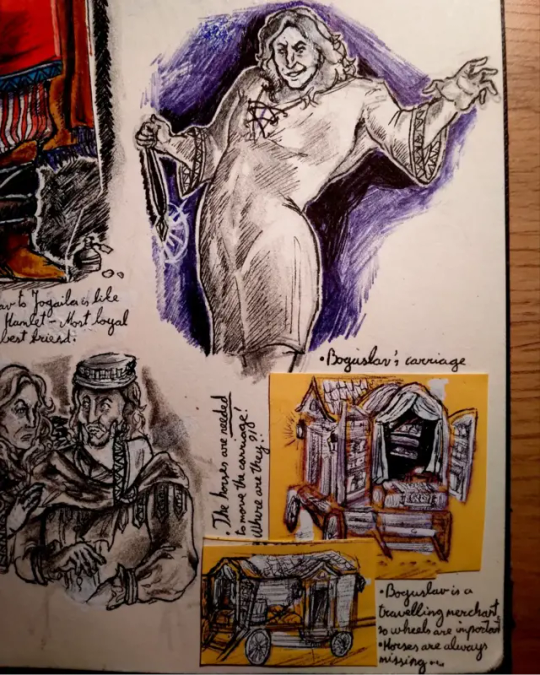
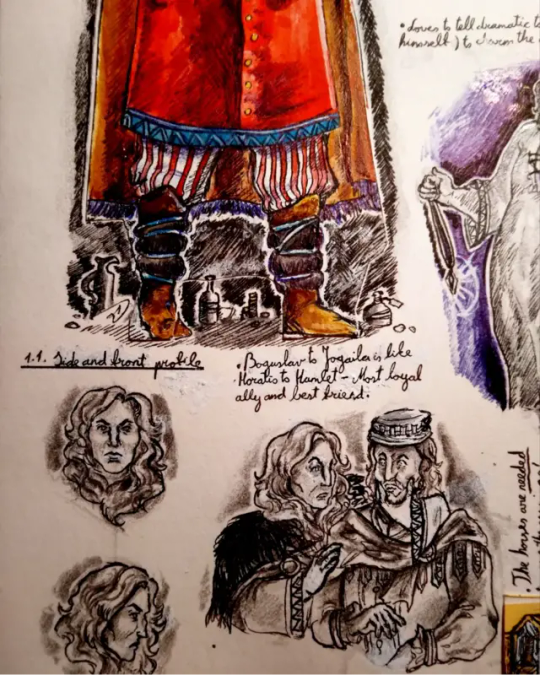
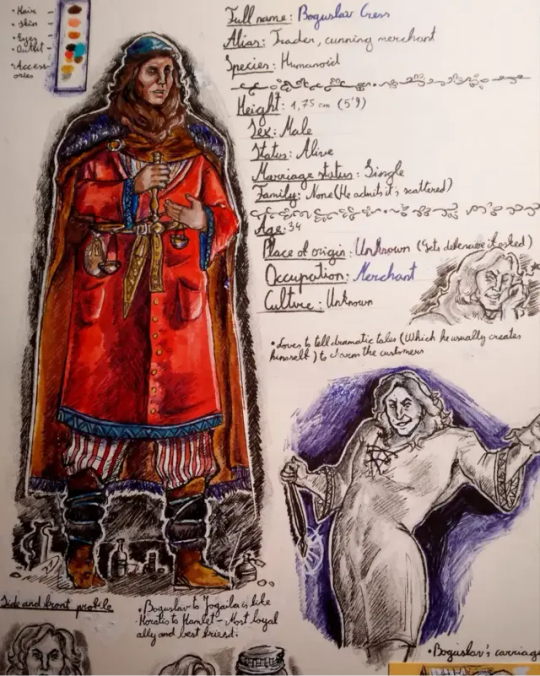
Boguslav is a mysterious and cunning merchant who serves as both Jogaila's ally and salesman. He is described as a well-educated, stoic, passionate and pious man who was for many years a merchant in the local villages and capitals, making great profits from his business dealings. His cart is littered with supplies and trinkets. Boguslav's motives are often purely profit-seeking, as he is willing to do business with anyone. With witty and sharp jokes, he is quite charismatic and can attract interest with his offers easly.
6 notes
·
View notes